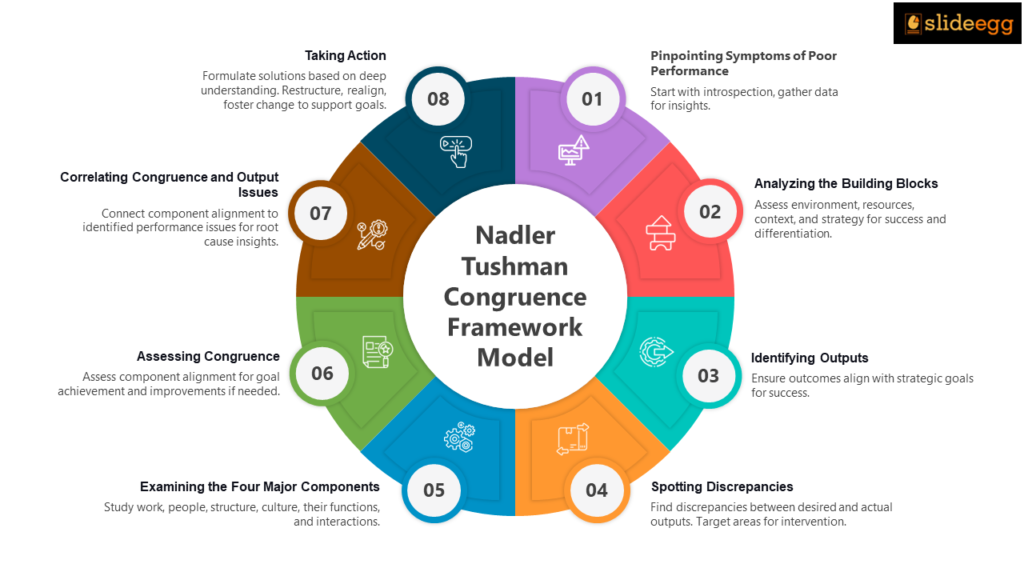The Nadler-Tushman Congruence Model was developed by Michael L. Tushman and David A. Nadler at Columbia University in the early 1980s.
The Nadler-Tushman Congruence Model can be used to identify areas of incongruence and develop strategies to improve alignment. This can help organizations improve their performance and achieve their goals.
In today’s competitive business world, organizations are always looking for ways to improve their performance. The Nadler-Tushman Congruence Model is a tool that can help organizations do this by identifying and addressing any gaps between the four key elements of an organization: work, people, structure, and culture.
The model is based on the idea that when these four elements are in alignment or congruent, an organization is more likely to be successful. When there is incongruence, or a mismatch, between these elements, it can lead to problems such as low productivity, employee turnover, and customer dissatisfaction.
Understanding the Congruence Model
At its core, the Nadler-Tushman Congruence Model serves as a diagnostic tool to evaluate and enhance organizational effectiveness. It operates on the fundamental premise that when these four critical elements are in sync, an organization’s performance soars to new heights.
Here are the four crucial elements mentioned in the Nadler-Tushman Congruence framework model:
- Work: This component refers to the tasks, processes, and activities that individuals and groups within the organization engage in to achieve their goals. It encompasses the specific jobs people perform and how those jobs are designed and organized.
- People: The people component includes the individuals who make up the organization, their skills, capabilities, and behaviors. It considers factors like employee skills, attitudes, and motivation, as well as how they work together as teams.
- Structure: Structure pertains to the organization’s formal systems, hierarchy, and reporting relationships. It encompasses the organizational chart, decision-making processes, and how authority and responsibility are distributed.
- Culture: Culture represents the shared values, beliefs, norms, and behaviors that characterize an organization. It’s the “personality” of the organization and influences how employees interact, make decisions, and approach their work.

Click the image to locate it visually. Get more categories on Slide Egg.
Here is the method to use this congruence model, just follow this type of steps to build the model. Here we go,
1. Pinpointing Symptoms of Poor Performance
The journey towards improvement begins with an introspective look. Gather all the data that points toward the symptoms of poor performance within your organization. This data provides crucial insights into the areas that require attention.
2. Analyzing the Building Blocks
Inputs are the raw materials an organization works with, including its environment, resources, and historical context. They lay the foundation for success. Specify and analyze these inputs, and define your organization’s strategy. What sets you apart, and how do you plan to achieve your goals?
3. Identifying Outputs: Aligning Objectives
Outputs represent the outcomes an organization seeks to achieve, be it at the individual, group, or organizational levels. These outputs should be tightly aligned with the strategic objectives. When the two are in sync, success becomes more attainable.
4. Spotting Discrepancies
Now comes the critical step: pinpointing the gaps between the desired and actual outputs. What’s holding your organization back from achieving its goals? Identify these discrepancies and associated costs. This step often reveals the areas where intervention is most needed.
5. Examining the Four Major Components
Your organization is a complex entity, comprising work, people, structure, and culture. Collect data on and describe the basic nature of these four components. Understand how they function and interact within your organization.
6. Assessing Congruence: Seeking Harmony
The degree of congruence among these components is the linchpin of success. Assess how well they align. The higher the compatibility, the greater the chances of achieving your goals. This step is pivotal in identifying where improvements may be required.
7. Correlating Congruence and Output Issues
Now, connect the dots. Determine if poor congruence among the four major components is related to the output problems you identified earlier. Often, the root causes of performance issues become more apparent at this stage.
8. Taking Action: Crafting Solutions
Armed with a deeper understanding of your organization’s inner workings, it’s time to formulate action steps to address the root causes of performance problems. These solutions may involve restructuring, realigning strategies, or fostering cultural change. The key is to ensure that your organization’s elements are congruent and supportive of its goals.
Advantages and Disadvantages of the Congruence Model
The Nadler and Tushman congruence model perceives organizations and companies as interconnected components operating in harmony. However, it’s essential to consider certain limitations when evaluating its applicability to your organization.
Advantages
This model offers a comprehensive framework for analyzing complex organizational issues. It serves as a thinking tool for addressing administrative problems rather than a rigid template for observation and classification. Additionally, it empowers corporate leaders to explore its four elements and provide flexible solutions.
When organizations employ this model, it aids in assessing the potential effects of management changes on organizational performance and interactions. It underscores the need for alignment between technical components (such as tasks and organizational structures) and social elements like people and culture.
Disadvantages
The congruence model can be costly and time-consuming, especially for large organizations with numerous business units and thousands of employees. It lacks a specific and direct method for incorporating group dynamics into organizational analyses.
Because the congruence model lacks a structured template, offering organizational leaders flexibility may hinder their ability to promptly devise solutions to organizational challenges.”
When implementing changes to prevent the emergence of additional issues. Altering one relationship may have repercussions on others, so it’s crucial to assess the potential consequences of each modification.
Strive to enhance alignment among the organizational culture, structure, work processes, and personnel. Achieving this harmony can lead to an improvement in your organization’s overall performance.
In a world where adaptability and efficiency are paramount, the Nadler-Tushman Congruence Model stands as a beacon of guidance for organizations seeking to enhance their performance. By diligently assessing and aligning the essential elements of work, people, structure, and culture, you can unlock your organization’s full potential and pave the way for sustained success. Embrace the power of congruence, and watch your organization thrive.







